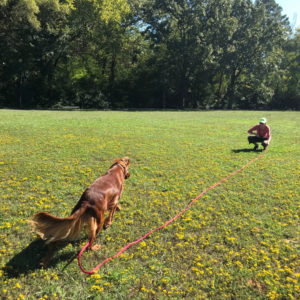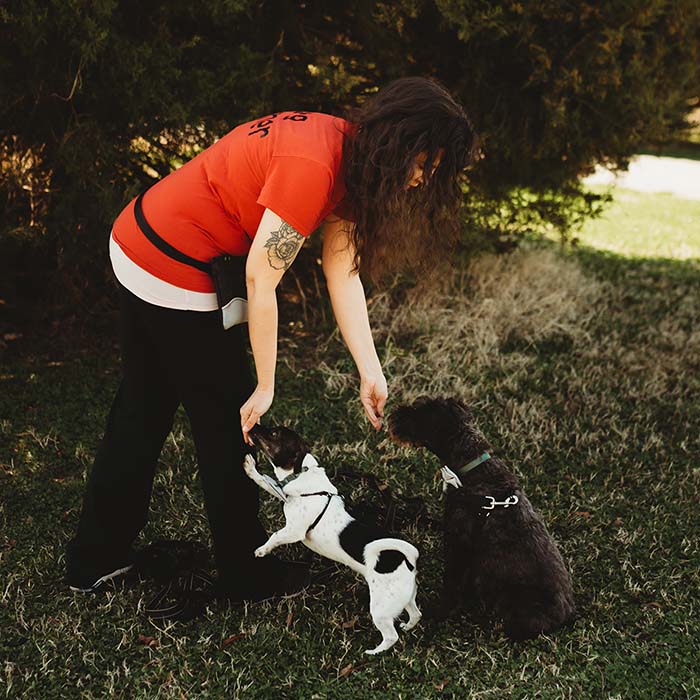Don’t Feed Your Puppy Grain-Free Food
A Conversation about Puppies between a Dog Trainer and a Veterinarian
Dr. Marlow Ball, the owner and veterinarian behind SoMa Animal Clinic and Housecalls, opened her house call practice three years ago.
She’s worked as a veterinarian for nine years, and she decided to provide a brick and mortar practice one year ago in downtown Little Rock. She focuses on compassionate end-of-life care and fear-free methods for pets of all ages. “I continue to offer house calls for end of life, and wellness visits,” Dr. Ball shared. “Fear free is a very important thing to me. Trying to minimize the stress to our patients, and the barriers to their veterinary care [is] really important to me. We’ve tried to set this practice up to reduce fear and anxiety and support owners working through those challenges with our patients.”
Dr. Ball sat down with me, Elizabeth, your friendly neighborhood Little Rock dog trainer and the person behind Telltail Dog Training, to discuss what important things to watch out for when bringing a new puppy home. Regarding puppies, there are some questions that are important for a veterinarian to answer, and while others are more appropriate for a dog trainer.
We’re offering a safe socialization event for puppies! Join me and Dr. Ball on Tuesday, January 28 at 6 pm for our Young Paws Social. There are ten spots available at $15 each. Puppies must have received their first two rounds of vaccinations. We’ll both be available to answer questions, and we’ll even do some training along with playtime for the puppies. Email info@telltaildogtrainin.com or call (501) 916-2246 to get on the list!
I brought my puppy home seven years ago, when he was eight weeks old, and I had no idea what I was doing. I even wrote up a list of questions to ask my veterinarian at the time, which included, “How do I get my puppy more comfortable walking on a leash?”
This wasn’t a question for a veterinarian, but I didn’t know any better.
I’d done all my research, or at least as much as I could. As a dog trainer now with a lot of experience with dogs of all ages and breeds and able to research much more effectively, I can look back and have a good chuckle at my younger self.
Vaccinations and Socialization
Puppies are at their most vulnerable right when they need socialization the most: before their fourth month. Here’s a paper (PDF) from the American Veterinary Society of Animal Behavior (AVSAB) that stresses the need for early socialization, published 11 years ago. So we’ve known for a long time that socialization is important for puppies. Safe, responsible socialization helps a puppy experience the world in a way that reduces stress and eases their fear periods as they grow.
But puppies aren’t properly vaccinated until four months old.
Before then, they are vulnerable to contracting contagious diseases like parvo and distemper. “Puppies need a series of vaccines every two to four weeks in order to have protection against a lot of contagious diseases,” Dr. Ball explained. “As a veterinarian, I will typically recommend that until a pet has had a full series of vaccines, that they are not in places where unknown dogs have been. So don’t take them to Petsmart to walk around. Don’t take them to the dog park. I want to try to reduce their exposure to things that could make them sick until they’ve had enough vaccines to have protection.”
Parvo “spreads either by direct contact with an infected dog, or through feces, and an infected dog can begin shedding the virus four-to-five days after exposure — often before the dog starts exhibiting any clinical signs of infection. … The canine parvovirus causes parvo in dogs, and it can be transmitted in two ways. The first is by direct contact through the nose and mouth with infected poop, which can happen when a dog sniffs or licks a surface or another dog that has been contaminated with feces.”
What Every Owner Should Know About Parvo in Dogs, the American Kennel Club
“Canine distemper is a virus that affects a dog’s respiratory, gastrointestinal, respiratory and central nervous systems, as well as the conjunctival membranes of the eye.”
ASPCA Virtual Pet Behaviorist, WebMD Veterinary Reference
As a dog trainer, I won’t answer any medical questions. Those are appropriate for your vet.
Dr. Ball can advise on when to vaccinate and for what. She also asks about lifestyle to inform vaccination recommendations. “I want to recommend certain vaccines based on that lifestyle and the risks for my patient,” Dr. Ball explained. “I enjoy answering questions on how to decide, does your dog need the flu? If they’re going to lots of places and interacting with lots of dogs, we should vaccinate them for that. If they are a couch potato who stays in the yard, they don’t necessarily need all of the vaccines.”
Spaying/Neutering, Heartworm Prevention, Flea and Tick Prevention
Other great questions for your veterinarian include when to spay or neuter, heartworm prevention, and flea and tick prevention options. “Those are things we should be talking about to make sure our pets are properly protected,” Dr. Ball explained.
Puppy List
Are you ready?
- Lifestyle Research
Dr. Ball suggested that the first step is researching the lifestyle that you have and the dog that you’re going to bring home. “I see a lot of mismatch, where a sedentary family gets a golden retriever puppy,” Dr. Ball explained. “We need to make sure, before you bring the pet home, that you have thought a lot about what’s going to fit. I love when people foster to adopt. You can foster with many different rescue groups, and make sure that this is going to be a good fit for your family before you finalize the adoption, and I think that’s one of the best ways to bring a dog home because you’re going to learn more about what you need from a dog and what’s going to fit for your family.” - Pick Your Veterinarian
When bringing home a new puppy or rescue, it’s important to have an incubation period of ten to fourteen days of keeping your new pet away from any existing animals. Dogs can easily be sick without showing any signs of illness. Also, behaviorally, it is a much easier process of introducing your new pet to others when there’s been a gradual introduction. - Collar and Leash
Dr. Ball says to check the collar regularly! It is very easy for a puppy to grow quickly, and it can take as little as a week for the collar to get embedded and cause problems. - Harness
Some puppies go wild at the end of a leash and pull like crazy. Leash training is very helpful in reducing that strain on a puppy’s neck and trachea. I often recommend the PetSafe Easy Walk, which clips to the chest instead of the back, which prevents the leverage dogs often rely on to pull their owner forward. - Dog Food
Avoid grain-free diets until there’s more research on how grain-free impacts dogs. Dr. Ball recommends Purina Pro Plan, Iams, Science Diet, or Royal Canin due to the amount of scientific research available. - Human Food
Being careful of dog food doesn’t mean our dogs can’t have snacks. Dr. Ball shared some veterinarian-approved snacks like carrots, green beans, pumpkin, and low-sodium chicken broth. - Treats
Treats are helpful for reinforcing desirable behaviors. If you’d like to use “sit” as “please”, for example, reward your dog when they sit in front of you, even if you haven’t asked. This helps encourage a sit instead of a jump when they would like some attention, much like training kids to say “please” when they need or want something. It is never too early to start training. Dr. Ball recommends treats that are easy to break into small pieces, from companies like Purina, Science Diet, or Iams. - Water and Food Bowls
- Toys
Human hands are typically the best chew toy ever, so having a variety of toys on hand will help redirect any mouthing or chewing. A wet towel or washcloth, frozen in the freezer, or carrots can help relieve puppies of pain while they are teething. - Puppy Pads
Puppy pads can help with accidents but may complicate potty training if they are relied upon. When using a gated section of the home instead of a crate, puppy pads can give puppies an option while they are learning how to go potty outside reliably.
If you’d like to crate train, then add a crate to the list! Crate training is very helpful for quite a few reasons, but it’s much more than putting a dog in a cage and leaving them for hours.
The potty training method I like to use for puppies is outlined in Perfect Puppy in 7 Days, by Dr. Sophia Yin. Puppies understand that they can go to the bathroom outside, but they don’t always understand that they shouldn’t go potty inside. Dr. Yin’s method is that an owner has an eye on their puppy, or the puppy is on a leash, or the puppy is in a contained area, like a crate, while potty training. A small gated section of the house would work for this as well. Puppies generally can “hold it” for how many months they are. A two-month-old puppy can be left alone for two hours, etc. Puppies should be given regular potty breaks. Older dogs may vary on what they can do. Some may be able to go eight hours being accident free, while others may need breaks every four hours.
I’ll be doing a more in-depth episode and article on crate training with Dr. Ball, since she gets this question all the time. For now, it is most helpful to build up the crate through positive reinforcement as a fun place for your puppy to be. This includes allowing your dog to go into the crate on their own with a special treat and making sure that they have been exercised and trained before they go into the crate. Most dogs need a break from constant activity or noise. A crate can be a refuge for a dog.
Dog Food
In general, dog food questions are great for your veterinarian, who will not only help you choose a food that is appropriate for your dog, but advise you on how often to feed, especially while your puppy is young. Your veterinarian will have done the research and analyzed the science behind the current food available, unlike your trainer or a doggy daycare employee. Ideally, the rescue or breeder would provide a portion of the dog’s current food so there can be a transition to the new food, Dr. Ball shared. Also be aware that there are food fads for animals, much like there are for humans. Dr. Ball advises against grain-free diets for dogs. “I’m concerned because when I walk through the aisles at Petsmart or Petco, everything is grain-free,” Dr. Ball explained. “Grain-free is not a common condition that we see in dogs. It is not something that is a common source for allergies or health issues for dogs. And now we’re seeing some end-stage heart failure from a possible taurine deficiency in a lot of these grain-free diets. It’s a lot like human nutrition. If there was one diet that was perfect and worked for every single person, there wouldn’t be 5,000 diets.”
Some current diets are substituting legumes or peas as protein sources. “There’s just a lot that we don’t know,” Dr. Ball shared. “I definitely recommend avoiding a grain-free diet until we know more about how to make them safe for our patients. Make sure that they are on a puppy food. A large breed dog should be on a large breed dog food. It’s going to have restricted calories and nutrition based on what the growth of the dog will be. There’s many brands out there. I tend to recommend Purina Pro Plan, Iams, Science Diet, Royal Canin. Those are the companies that tend to have the most veterinary research that I can look into.”
Dr. Ball also recommends that the dog food be AAFCO approved. “That means it meets the minimal nutrition requirements to maintain a dog,” Dr. Ball said. “Those are the big things. There are just a lot of trends right now that are not based on health research and now we are seeing health complications from these diets. And it seems like, and this is true for human medicine as well, nutrition research is very behind. Right now, everyone’s on Keto diets and we just don’t necessarily have the research. And it’s even further behind in the veterinary nutrition and animal nutrition.”
She added, “Until we know more, we need to be really careful about how we chose appropriate diets for our pets.”
But being careful of dog food doesn’t mean our dogs can’t have human food snacks. Dr. Ball shared some veterinarian-approved snacks, like carrots, green beans, pumpkin, and low-sodium chicken broth. Dr. Ball explained that green beans can be helpful for any issues with anal glands, diarrhea or weight loss needs. Canned green beans can be used as long as they are low sodium. Dr. Ball added that pumpkin can also help with anal gland issues and help firm up stools.
As well as being a good treat for the summer, Dr. Ball utilizes chicken broth popsicles or a Kong for her fear-free practice methods as well. “We have a whole bag of doggy popsicles, and when we have a dog that’s fearful, we will give them a doggy popsicle to help distract them from a toenail trim,” Dr. Ball shared. “They’re more interested in eating and sometimes they don’t even realize that we’ve given them a shot. That’s one of the fear-free techniques we use to reduce stress.”
When bringing a new pet home, Dr. Ball suggests picking a veterinarian before the new dog arrives. “I strongly recommend a physical exam within a few days of adopting a dog so your veterinarian can look at previous vaccines and make recommendations,” she shared.
And she recommends quarantining a new dog from existing pets for ten to fourteen days. “A lot of diseases have an incubation period so they may look completely normal, but they are already sick with something,” Dr. Ball said. “I’ve seen someone adopt a new dog, and then everyone comes down with kennel cough. I just want people to be aware that you can bring your dog into your vet and they look perfectly normal. They are perfectly normal, but they may be incubating an illness that will take days to show up. So I love doing an exam when people first get the dog and then figuring out when we need to schedule the next round of puppy shots.”
Quarantining also helps with introductions to any new dogs as well. As a trainer, I recommend the same amount of time before slow introductions begin, which helps everybody get used to the intruder. There is a higher rate of success by going slow instead of throwing the dogs together and expecting them to work it out.
Be sure to supervise your puppy when they are interacting with a treat like a rawhide or a squeaky toy. “Every dog has a different behavior, and I’ve seen so many dogs eat and swallow toys that cause serious health problems,” Dr. Ball shared. “I don’t think every and any dog should have a rawhide. I think we need to supervise and know if a dog is going to swallow it whole. A, it does nothing for their teeth, and B, it becomes a health hazard. Sometimes you have to play around and find what works best for each personal behavior of a puppy.”
Young Paws Club
We decided to team up! I’ll be offering a Young Paws Club with Dr. Ball at SoMa Animal Clinic on Tuesday, January 28 at 6 pm. We’ll both be on hand to answer questions, and I’ll lead the group through appropriate play and help train on some training commands, like sit, down, and touch. “This is a controlled environment where we know that puppies that are here have been properly vaccinated,” Dr. Ball said. “We know that the facility has been disinfected properly to prevent the spread of contagious diseases. So many things, like parvo, can even be spread from your shoes. … I love the idea that these young puppies are properly vaccinated and have a controlled environment for them to socialize.”
Email Elizabeth at info@telltaildogtraining.com or call the clinic at (501) 916-2246 to get on the list. There are only ten slots for this event, but we may offer monthly or even weekly options if there’s enough interest. Puppies must have their records on file at the clinic, even if Dr. Ball is not their veterinarian, and the first two rounds of puppy shots should be completed.
Telltail Dog Training offers group classes and private in-home lessons in the Little Rock area, along with training walks for current clients. Find Telltail’s podcast here, or find additional information on Instagram, Facebook and YouTube. Visit SoMa Animal Clinic’s website or Facebook for more information.



